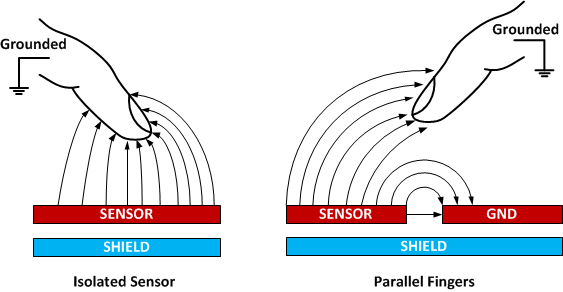SNOAA90A february 2023 – may 2023 DRV5033-Q1 , LDC3114-Q1 , TMAG5170-Q1 , TMAG5170D-Q1 , TMAG5173-Q1
2.3 Capacitive Touch Buttons
Capacitive touch buttons are a common replacement for mechanical push buttons. Capacitive touch buttons provide a flat touch surface that can work with a light user touch. These buttons function by using the capacitive characteristics of the human body to trigger a capacitive change when the touch button is pressed. On a fundamental level, the fringing effect of an electrode couples to the finger of the user as the finger approaches the touch surface, causing a capacitive shift that can be interpreted as a touch.
 Figure 2-3 Capacitive Sensor Fringing Electric Fields for Isolated and Parallel Finger Topologies
Figure 2-3 Capacitive Sensor Fringing Electric Fields for Isolated and Parallel Finger TopologiesDue to this functionality, capacitive touch buttons are a good option for a seamless HMI panel. Capacitive touch buttons can also be used as proximity sensors so the user does not even have to touch the surface. One downside to these buttons is their reliance on the capacitance from the hand. Wearing gloves can make sensing the touch event more difficult. Additionally, usage on the external surfaces of a vehicle like a door handle can mean that metal must be used for the touch surface. Metal touch surfaces change the topology to be more of a parallel plate capacitor because the fringing effect couples to the metal surface. In this style of implementation, the change in distance between the plates causes a capacitive change that can be used to detect a button press.
 Figure 2-4 Capacitive Touch on Metal
Figure 2-4 Capacitive Touch on MetalIn this type of implementation, using the capacitive sensor with gloves is easier because the metal moves either way, however this implementation can require grounding the touch surface to reduce the amount of noise in the measurement. The Capacitive Touch Through Metal Using MSP430 MCUs with CapTIvate Technology application note goes into more details on this application.